Nikon D700 Review
Review Date: September 3rd 2008
Author: Gavin Stoker
Leave a comment about this Review
|
Introduction

The D700 is Nikon's second full-frame, FX-series DSLR camera, following on from the more expensive pro D3 model. The Nikon D700 features the same 36x24mm, full frame, 12.1 megapixel CMOS sensor as the D3, housed in a more compact and lighter body. The amazing ISO range of the D3 is retained by the D700 - ISO 100 - 25600 should cover most lighting conditions! It also borrows liberally from the cheaper D300 model, with the same integrated dust reduction system, almost identical continuous shooting speeds, and similar control layout. All three high-end Nikon DSLRs offer a 51-point auto-focus system, 3 inch LCD screen, Live View mode and a HDMI port for connection to a HDTV. You do have to pay a price-premium for the full-frame capabilities of the Nikon D700 - �1999.99 / �2599.00 / $2999.95 to be exact - but this is a lot cheaper than the D3. Gavin Stoker finds out if the new Nikon D700 is just a confusing mix of the D3 and D300, or a compelling camera in its own right...
Compare Prices
Support PhotographyBLOG: Buy the Nikon D700 from one of our affiliate retailers:Ease of Use
Our recent review of the 12-megapixel CMOS sensor-sporting DX format D300 concluded that it was, for most intents and purposes, 'all the DSLR you'd ever need'. So will there be any superlatives left in the trunk for lauding the newer D700, which sits in Nikon's range between that earlier DSLR and its equally recommended bigger brother, the D3, while borrowing liberally from both?
The Nikon D700's headline specification includes an effective resolution of 12.1 million pixels from a full frame FX format CMOS sensor, the same as that found within the D3. It's Nikon's second FX camera after that flagship model, the difference being that, like the D300, it sports a smaller and lighter body design while retaining its 3-inch LCD with Live View. At 995g without accessories though, the D700 is still reassuringly hefty and brick-like when gripped. In fact it boasts a thicker magnesium alloy body than the D300, along with better weather sealing that, claims Nikon, may not be of quite the same standard as the D3, but is not far behind. So, in the Nikon D700, are we looking at a 'best of both worlds' DSLR for the pro, semi pro, or deep-pocketed enthusiast?
Arguably the D3's main selling point was not only full frame capture but also its frighteningly fast capture speed: nine frames per second or 11fps in DX crop mode (1.5x magnification factor). This enabled it to just nose ahead of its nearest competitor in Canon's 10fps, 10.1 megapixel 1D Mark III as the tool du jour for sports and action photographers. The D700 by contrast � and matching the D300 � offers up to a maximum 8fps, but with the caveat of requiring an optional multi-power battery pack to achieve said speed. Otherwise it's up to a less impressive (by contrast) 5fps, whereas the D300 offered a maximum 6fps. Still, at a body-only UK asking price of �1,999.99, the D700 does suggest itself as a back up for D3 owning professionals without � at first glance - too much in the way of compromise. After all it borrows the D3's (and D300's) 51-point auto focus system, and Nikon would have us believe the D700's response speeds are the same, with Expeed image processing once more on board to zip things along.
On launch, Nikon was also keen to flag up the fact that the D700 boasts an advanced scene recognition system that can detect human skin tones and track subjects by their colour. When using a type G or D lens and in Auto area AF mode � selected via a three-option switch on the camera back � it uses colour information and special face recognition algorithms to automatically focus on a subject's face. Nikon suggests this as an aid when there's not time to select a focus point, or alternatively when shooting handheld in Live View mode at high or low angles. We were sent a review sample that came bundled with a high performance standard lens in the AF Nikkor 50mm F/1.4D, suggesting that those shooting portraiture in available light � with the D700 again boasting light sensitivity topping out at an incredible ISO 25600 equivalent � are another prominent target market. Aiming at a greater variety of test samples we also managed to wangle an image stabilised (or as Nikon would have it VR-equipped) Nikkor 24-120mm f/3.5-5.6G (IF) zoom for more general-purpose photography.
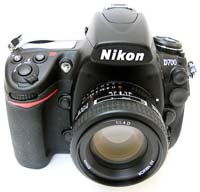 |
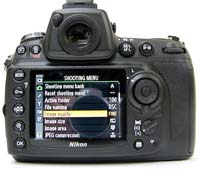 |
| Front | Rear |
Though your first impression when viewing the Nikon D700 front on is of a fairly clean fascia, that's because what ports and controls there are tend to visually fade into the D700's none�more-black matt bodywork. With lens mount positioned right of centre, top right of this are two ports covered with rubber flaps kept in place via attachment to the strap eyelet at the right hand side (viewed lens-on). As on the D300, these protect a flash sync terminal and beneath a ten pin remote port. As we noted at the time, both are preferable to the more usual screw cap or removable plug that could easily go astray. Immediately below this pairing is a raised lens release button, while below again is a rather stiff yet familiar three-option switch allowing the user to quickly alternate between the three focus modes. These are: single servo AF (the camera focusing when shutter button is depressed halfway), continuous servo AF (the camera engaging predictive focus tracking if the subject moves, with the default result that the shutter can occasionally be released even if the subject isn't in focus), or user-controlled manual focus option.
Remaining at the right of the lens mount, and moving up the Nikon D700 to just under the hump that houses the pop up flash, we find two buttons nestling into its gently curved slope. As on the D300, the top one activates the built-in flash, which springs immediately and satisfyingly upright with a dull clunk, while the lower one � when used in conjunction with the main command dial � provides access to the various flash modes or, with a twist of the sub command dial at the top of the grip, the ability to adjust its strength from -3EV to +1EV. The dials provide just the right amount of resistance, and the effect of turning them can be seen via the icons and numbers displayed in the top plate LCD, more on which later.
Still examining the Nikon D700's front plate and moving across to the other side of the lens we find a depth of field preview button and, a short distance below, a function button marked with the abbreviation 'Fn'. Pressing down on this and turning the main command dial located top right of the D700's back allows the user to control the number of bracketed shots in a sequence incrementally, from three shots to nine. Pressing down on this again, and alternatively rotating the sub command dial located at the top of the grip at the front, allows the selection of exposure increments. This Fn button can additionally be used in conjunction with the flash to lock down its output, maintaining a consistency of bulb strength appropriate to the subject even when they, or it, are not centre of the frame. Alternatively you can choose to customize the Fn button and assign to it a wide array of roles, accessed once again in conjunction with the command dials. As with its high-end forebears, there's certainly plenty to 'play' with on the D700.
Directly in a line with and above the DOF preview and Fn buttons at the front is a triple purpose window for the AF assist illuminator, self-timer lamp plus red-eye reduction lamp. Again this is exactly the same as that found on the D300. Finally, and above the familiar red Nikon signature strip at the top of the chunky handgrip, is the aforementioned sub command dial. Like the main command dial this is ridged to allow incremental accuracy when quickly spinning through options in the heat of the moment. Ergonomics are good too, it being readily accessed with a quick forward dart of the forefinger, seeing as it is positioned mere millimeters below the shutter release button. Incidentally, and not be in possession of the longest digits, I found squeezing my forefingers around the chunky grip on the D700 � approx 8cm in depth, 4cm in width � while my thumb rested on the rear leather-effect padding a tad uncomfortable at first. I don't recall the same issue when rating the D300 or D3, with perhaps the size difference more noticeable having come to the D700 from consumer models in the Canon's 1000D and Pentax's K20D. With 24-120mm lens attached, the D700 is truly doorstop like in both weight and dimensions.
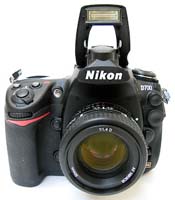 |
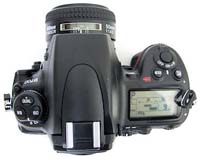 |
| Pop-Up Flash | Top |
Looking down on the top of the Nikon D700 next, we find a control layout identical to the D300 and D3 on the right hand side. This comprises a shooting info-packed LCD control panel (or, if you prefer, 'window'), forward of which is a dual use exposure/card format button, with a second exposure compensation button to the right. All buttons are springy with just the right amount of resistance to enforce the impression of a solid and reliable build with little if no compromise on quality. Forward of this again, on the slope for the handgrip, is the one and only shutter release button, encircled by the on/off power switch. However, when we move over to the far left, though similar again to the D3 on first glance we instead find a mode dial identically mirroring that of the D300, with, inset, a dedicated image quality/size button plus two further buttons for selecting white balance and ISO settings respectively. Light sensitivity can be manually adjusted through a whopping 23 increments, from setting Lo 0.3 (ISO 100 equivalent) through Hi 2 (ISO 25600 equivalent), running from a more conventionally presented ISO 200 through ISO 6400 in between. Of course auto ISO sensitivity is also offered.
Tucked underneath this raised (and fixed) knob housing this trio of buttons is a circular disk with its own individual lock button and settings for the following release modes: single frame capture, continuous low speed capture (between one and 5fps, or up to 7fps with battery pack), continuous high speed capture (up to 5fps normally, or 8fps with battery pack), plus dedicated Live View mode, self timer and/or mirror up mode as an aid to minimizing camera shake. In the middle of these two sets of controls sits the hump housing the built in flash, just set back from which is the familiar accessory shoe for optional Nikon Speedlight flash unit (compatibility offered with the SB-900, SB-800, SB-600, SB-400 and SB-R200), the contacts protected by a slide-out plastic cover when not in use.
So now down to business. Turn the on/off dial that encircles that main shutter release button and the Nikon D700 powers up for action in a fraction of a second � marginally faster than the D300 at 0.12/sec rather than 0.13/sec according to Nikon's own spec, so no grumbles there. While AF is lightning fast in determining your intended target, any shutter lag is imperceptible. The official figure is again a tad faster than the D300's 45 milliseconds at a mere 40, not that you'd notice. As we mentioned during our review of the D300, despite the fact that the D700 requires a fair bit of familiarisation to make use of all its on-board features � simply because there are so many functions you can tweak and customize to the nth degree � if required you can be up and shooting from the off fairly intuitively. Fortunately a rather hefty hard copy manual is provided for easy access should you need for reference. Whereas in single capture mode, large, fine quality JPEGs or TIFFs are committed to memory in an instant, a mere second to write a Raw file and enough buffer memory to rattle off an extended sequence in quick succession really impresses. Similarly shooting fine JPEGs in conjunction with Raw slows down proceedings imperceptibly. Basically, if a shot presents itself, you'll get it.
Rather than, as might be easier, Live View having its own button, instead it is activated via a twist of the aforementioned mode dial onto the relevant setting, and then delving into the camera's on-screen shooting menu. There's a choice of two modes: handheld, which is the default, or tripod, and Live View itself is activated by pressing the shutter release button down fully, at which point the mirror is raised and the view through the lens presented via the monitor instead. Once active, the view can be enlarged for more precise focus, using the zoom in or out buttons to the left of the LCD itself. As you'd expect the clear, real-time image on screen blanks out momentarily as you take the shot, while a press of the menu button brings you back out of the mode. A high resolution LCD undoubtedly helps validate this feature, though if we really are being picky one could grumble that ultimate freedom would be provided by the screen being of the tilt and swivel variety, rather than fixed.
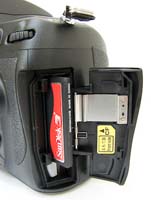 |
 |
| Memory Card Slot | Battery Compartment |
Moving around to the back of the Nikon D700, dominated by that main LCD screen, we find a smattering of controls 99% identical to those found on the D300, except here the D700 has its own dedicated info button bottom right of the back where the D300 previously had a catch for releasing its card compartment. Starting on the left hand flank of the D700, and running in a strip from top to bottom are, again, a pairing of icon-illustrated controls for image playback and deletion. In line with and beneath the playback button is a row of five further buttons. At the top is an equally obvious menu button, an image protection button for avoiding accidental deletion, a dual-purpose thumbnail display/zoom out button, a zoom-in button for checking the fidelity of images post capture or focus in Live View mode, and an OK button for effecting setting changes.
Centred above the LCD monitor is the viewfinder, which offers 95% field of view (rather than the D300's 100%) and which takes its design cue instead from the D3, with a rounded window encircled by a rubber eyepiece. To the left of this is an eyepiece shutter lever, allowing it to be removed if desired for the attachment of a diopter adjustment viewfinder lens. As expected, the viewfinder itself is large, bright and clear. For spectacle wearers, top right of the viewfinder and tucked away to the side is a diopter dial for adjusting the focus of the viewfinder. To the right of the viewfinder again is a further dial. The outer ring is for selection from a trio of metering modes, presented directly above, the button at its centre is, as on the D300, for auto exposure lock and auto focus lock. Alongside this is the AF-on button, which has the same effect as pressing the shutter release button halfway, and the main command dial, as previously highlighted.
Below this again, we find a raised and nicely tactile multi selector pad for tabbing through and selecting on-screen menu options encircled by the focus selector lock. With a choice of 51 focus points, as with D3 and D300, or 11, the camera's point of focus can be selected manually so that your intended subject is sharp wherever it is in the frame, and then of course the focus locked off. Again, as on the D300 and chunkier D3, beneath this we have the AF area mode selector, a switch presenting three user-selectable options: single point AF (for relatively static compositions), dynamic area AF (if the subject moves, the camera will adjust based on information from surrounding points) and auto area AF (the camera automatically detecting the subject and selecting the focus point). The final control on the Nikon D700's back, just below this, is the dedicated info button, which, when pressed, displays chosen settings in the rear view monitor and to a large extent mirrors the information provided in the top plate LCD. Unlike the D300 and D3, which find room on the camera back for a catch to release the door covering the memory card compartment, here you simply slide it open the side mounted door with finger or thumb.
As with the D300, the left hand side of the camera � if still viewed from the back � features a large rubber cover for its more extensive array of ports. Starting at the top you have an increasingly important HDMI port for connecting the camera up to a high definition TV or monitor, the more standard video out port, then USB and DC in power ports. The rubber catch attaching the cover to camera is one of the only things about the D700 that feels thin and flimsy, and you could imagine it being torn off with particularly heated or prolonged use. While the right hand flank of the D700 features that sliding cover protecting the CompactFlash slot, the base of the camera features a screw thread for a tripod, plus the catch-operated compartment for the chunky supplied EN-EL3e lithium ion battery (same as that utilized by the D300). Battery life is good � I was using the D700 over a period of a couple of weeks and still had juice left over to play with � though I did find the pack unusually tricky to remove � there's nothing visible when loaded to get a finger purchase on � when recharging was required.
So what of the Nikon D700's images? Can we tell the difference between images from the D3 or D300, or should we be able to? Let's find out�
|
![]() PhotographyBLOG
is a member of the DIWA
organisation. Our test results for the Nikon D700 have been submitted to DIWA
for comparison with test results for different samples of
the same camera model supplied by other DIWA
member sites.
PhotographyBLOG
is a member of the DIWA
organisation. Our test results for the Nikon D700 have been submitted to DIWA
for comparison with test results for different samples of
the same camera model supplied by other DIWA
member sites.
